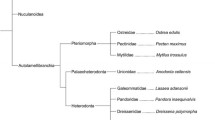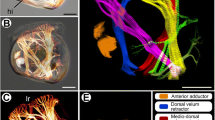Abstract
Recent studies on the differentiation of the body wall musculature in a medicinal leech and in the free-living plathelminth Macrostomum hystricinum marinum, Beklemischev 1950 provide the first evidence of a complex developmental signalling pattern, possibly involving stem cells and the nervous system, in the organization of the muscle grid formed by developing myocytes. To enhance further our understanding of the ontogenetic and phylogenetic origin of such muscle grids, which consist of circular, longitudinal and diagonal muscle fibres, we have undertaken a study of muscle development in the polyclad flatworm Hoploplana inquilina Wheeler 1894 in collaboration with the Marine Biological Laboratory, Woods Hole. We have also continued our examination of the development of the body wall musculature in M. hystricinum. Both species were studied using rhodamine-phalloidin staining and transmission electron microscopy. Additional visualization of the fluorescent whole mount preparations was performed with confocal laser microscopy and digital image processing. The results of our investigation suggest that: (1) the mechanism of muscle development in H. inquilina supports the deeply rooted concept of bilateral symmetry (right and left longitudinal founder muscle), and (2) a first circular muscle in this species develops on the border between an anterior body unit and the main body; a caudalmost region is less obvious. The presence of a spiral muscle functioning as a circular muscle system of the “head region” points to a separate developmental mechanism for this region and the trunk. In contrast to H. inquilina, where the larval stage forces an intermediate restructuring of the musculature of the body wall before the adult body shape is finally developed, the formation of the body wall musculature of M. hystricinum already seems constrained by the adult body shape.
Similar content being viewed by others
References
Ax P (1995) Das System der Metazoa I. Ein Lehrbuch der phylogenetischen Systematik. Fischer, Stuttgart
Baguña J, Boyer B (1990) Descriptive and experimental embryology of the Turbellaria: present knowledge, open questions and future trends. In: Mathy HJ (ed) Experimental embryology of aquatic plants and animals. Plenum Press, New York, pp 95–128
Baguña J, Romero R (1981) Quantitative analysis of cell types during growth, regrowth and regeneration in the planarians Dugesia (S) mediterranea and Dugesia (G) tigrina. Hydrobiologia 84:181–194
Baguña J, Salo E, Romero R (1989a) Effects of activators and antagonists of the neuropeptides substance P and substance K on cell proliferation in planarians. Int J Dev Biol 33:261–264
Baguna J, Salo E, Auladell C (1989b) Regeneration and pattern formation in planarians. III. Evidence that neoblasts are totipotent stem cells and the source of blastema cells. Development 107:77–86
Boyer BC (1987) Development of in vitro fertilized embryos of the polyclad flatworm Hoploplana inquilina following blastomere separation and deletion. Roux's Arch Dev Biol 196: 158–164
Brakenhoff GJ, Voort HTM van der, Spronsen EA van, Nanninga N (1990) Three dimensional imaging in fluorescence by confocal scanning microscopy. J Microsc 153:151–159
Ehlers U II (1995) The basic organization of the Plathelminthes. Hydrobiologia 305:21–26
Eisenman EA, Alfert M (1982) A new fixation procedure for preserving the ultrastructure of marine invertebrate tissue. J Microsc 125:117
Fransen ME (1982) The role of ECM in the development of invertebrates: A phylogeneticist's view. In: Hawkes S, Wang JL (eds) Extracellular matrix. Academic Press, pp 177–181
Gelhen M (1989) Morphologische und populationsdynamische Untersuchungen an experimentellen und natuerlichen Populationen des Macrostomum hystricinum marinum Rieger (Macrostomida). Thesis, University of Innsbruck
Gelhen M, Lochs A (1990) Quantification of characters from live observations in meiobenthic Turbellaria-Macrostomida. Cah Biol Mar 31:463–472
Ho RK, Ball EE, Goodman CS (1983) Muscle poineers: large mesodermal cells that erect a scaffold for developing muscles and motoneurones in grasshopper embryos. Nature 301:66–69
Jellies J (1990) Muscle assembly in simple systems. Trends Neurosci 13:126–131
Jellies J (1994a) Cellular interactions in the development of Annelid neuromuscular systems (abstract). Am Zool 33:98A
Jellies J (1994b) Cellular interactions in the development of Annelid neuromuscular systems. Am Zool 34:554–561
Jellies J, Kristan WB Jr (1988) Embryonic assembly of a complex muscle is directed by a single identified cell in the medicinical leech. J Neurosci 8:3317–3326
Lacalli TC (1983) The brain and central nervous system of Müller's larva. Can J Zool 61:39–51
Lawrence PA (1992) The making of a fly. The genetics of animal design. Blackwell, Cambridge
Legniti A, Rieger RM, Haszprunar G (1989) Cellular components in the acoelomate body cavity in the hatchling and the adult of Macrostomum hystricinum (Turbellaria, Macrostomida) (abstract). Eur J Cell Biol 49 [Suppl 27]:55
Maine EM, Kimble J (1993) Suppressors of GLP-1, a gene required for cell communication during development in Caenorhabditis-Elegans, define a set of interacting genes. Genetics 135:1011–1022
Mclennan IS (1993) Localization of transforming growth-factor-beta-1 in developing muscles — implications for connective-tissue and fiber-type pattern-formation. Dev Dynam 197:281–290
Marusich MF, Simpson SB Jr (1983) Changes in cell surface antigens during in vitro lizard myogenesis. Dev Biol 97:313–328
Palmberg I (1990) Stem cells in Microturbellarians. An immunocytochemical and autoradiographical study. Protoplasma 158: 109–111
Pawley J (1995) Handbook of biological confocal microscopy 2nd edn. Plenum Press, New York
Pedersen KJ (1991) Invited review: Structure and composition of basement membranes and other basal matrix systems in selected invertebrates. Acta Zool (Stockh) 72:181–201
Prudhoe S (1985) A monograph on polyclad Turbellaria. Oxford University Press, Oxford
Raff RA (1994) Developmental mechanisms in the evolution of animal form: origins and evolvability of body plans. In: Bengston S (ed) Early life on earth. (Nobel Symposium 84) Columbia University Press, New York, pp 489–500
Reuter M, Palmberg I (1989) Development and differentiation of neuronal subsets in asexually reproducing Microstomum lineare. Immunocytochemistry of 5-HT, RF-amide and SCPB. Histochemistry 91:123–131
Rieger RM (1994a) Evolution of the “lower” Metazoa. In: Bengston S (ed) Early life on earth. (Nobel Symposium 84) Columbia University Press, New York, pp 475–488
Rieger RM (1994b) The biphasic life cycle — a central theme of Metazoan evolution. Am Zool 34:484–491
Rieger RM, Salvenmoser W (1991) Demonstration of the musclesystem in whole mounts of Macrostomum hystricinum (Turbellaria, Macrostomida). Am Zool 31:25a
Rieger RM, Gehlen M, Haszprunar G, Holmlund M, Legniti A, Salvenmoser W, Tyler S (1988) Laboratory cultures of marine Macrostomida (Turbellaria). Fortschr Zool 36:523
Rieger RM, Salvenmoser W, Legnitti A, Reindl S, Adam H, Simonsberger P, Tyler S (1991a) Organization and differentiation of the bodywall musculature in Macrostomum (Turbellaria, Macrostomida). Hydrobiologia 227:119–129
Rieger RM, Tyler S, Smith JPS, Rieger G (1991b) Plathyhelminthes: Turbellaria (Chapter 2). In: Harrisson FW, Bogitsch BJ (eds) Plathyhelminthes and Nemertinea. (Microscopic anatomy of invertebrates, vol 3) Wiley-Liss, New York, pp 7–140
Rieger RM, Salvenmoser W, Legniti A, Tyler S (1994) Rhodamine-phalloidin preparations of Macrostomum hystricinum marinum (Plathelminthes) morphology and postembryonic development. Zoomorphology 114:133–147
Rieger RM, Salvenmoser W, Reiter D, Boyer BC (1995) Differentiation of the body wall musculature in Macrostomum and Haploplana (“Turbellaria”, Plathyhelminthes) (abstract). Hydrobiologia 305:225
Seilern-Aspang F (1957) Die Entwicklung von Macrostomum appendiculatum (Fabricius). Zool Jahrb Anat 76:311–330
Stefanini M (1967) Fixation of ejaculated spermatozoa for electron microscopy. Nature 216:173
Torrance SA, Stuart DK (1986) Gangliogenesis in leech embryos: migration of neural precursor cells. J Neurosci 6:2736–2746
Tyler S (1981) Development of cilia in embryos of the turbellarian Macrostomum. Hydrobiologia 84:231–239
Tyler S, Hyra GS, Rieger RM (1994) Three-dimensional visualization of musculature in the acoelomate worm Convoluta pulchra (Turbellaria). Am Zool 33:115
Author information
Authors and Affiliations
Rights and permissions
About this article
Cite this article
Reiter, D., Ladurner, P., Mair, G. et al. Differentiation of the body wall musculature in Macrostomum hystricinum marinum and Hoploplana inquilina (Plathelminthes), as models for muscle development in lower Spiralia. Roux's Arch Dev Biol 205, 410–423 (1996). https://doi.org/10.1007/BF00377221
Received:
Accepted:
Issue Date:
DOI: https://doi.org/10.1007/BF00377221




